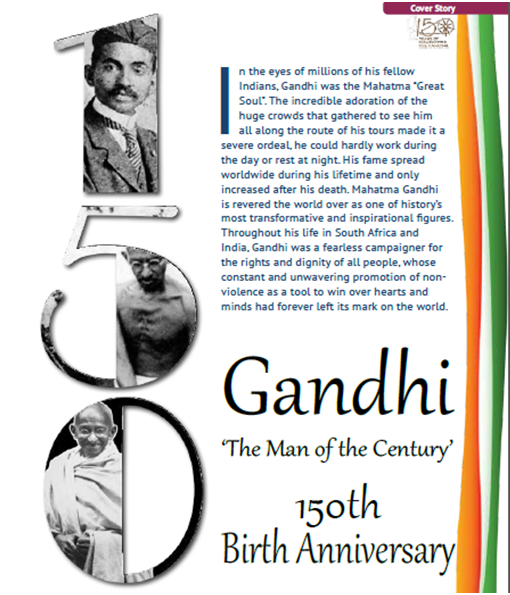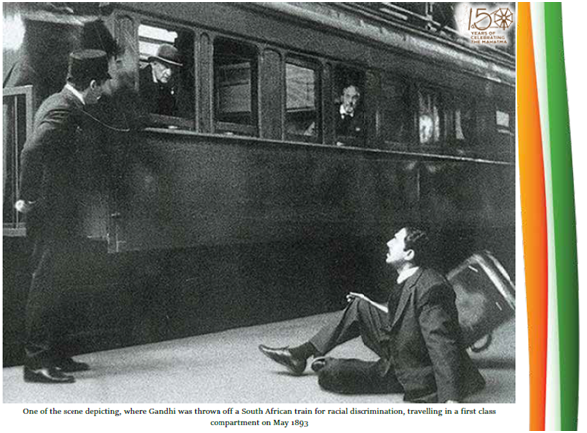
In the eyes of millions of his fellow Indians, Gandhi was the Mahatma “Great Soul”. The unthinking adoration of the huge crowds that gathered to see him all along the route of his tours made them a severe ordeal, he could hardly work during the day or rest at night. His fame spread worldwide during his lifetime and only increased after his death. Mahatma Gandhi revered the world over as one of history’s most transformative and inspirational figures. Throughout his life in South Africa and India, Gandhi was a fearless campaigner for the rights and dignity of all people, whose constant and unwavering promotion of non-violence as a tool to win over hearts and minds had forever left its mark on the world.
Subhash Chandra Bose had called him ‘Father of the Nation’ in his message on Hind Azad Radio. Rabindranath Tagore addressed him as ‘Mahatma’ and the latter called the poet “Gurudev’.
Mohandas Karamchand Gandhi was born on October 2, 1869, at Porbandar, a small town in Gujarat, on the sea coast of Western India. He was born in the distinguished family of administrators. His grandfather had risen to be the Dewan or Prime Minister of Porbandar and was succeeded by his father Karamchand Gandhiji .His mother Putlibai, a religious person, had a major contribution in moulding the character of young Mohan.
He studied initially at an elementary school in Porbandar and then at primary and high schools in Rajkot, one of the important cities of Gujarat. Though he called himself a ‘mediocre student’, he gave evidence of his reasoning, intelligence, deep faith in the principles of truth and discipline at very young age. He was married, at the age of thirteen, when still in high school, to Kasturbai who was of the same age, and had four sons named Harilal, Ramdas, Manilal and Devdas. His father died in 1885. At that time Gandhiji was studying at Samaldas College in Bhavnagar.
It was hoped that his Mohandas’s going to England and qualifying as a barrister would help his family to lead more comfortable life. He sailed to England on September 4, 1888 at the age of 18, and was enrolled in ‘The Inner Temple’. It was a new world for young Mohan and offered immense opportunities to explore new ideas and to reflect on the philosophy and religion of his own country. He got deeply interested in vegetarianism and study of different religions. His stay in England provided opportunities for widening horizons and better understanding of religions and cultures. He passed his examinations and was called to Bar on June 10, 1891. After two days he sailed for India.

The U Turn in His life from becoming ‘Gandhi’ to ‘Mahatma Gandhi’
He made unsuccessful attempts to establish his legal practice at Rajkot and Bombay. An offer from Dada Abdulla & Company to go to South Africa opened up a new chapter in his life.
When Gandhi arrived in South Africa, he was quickly appalled by the discrimination and racial segregation faced by Indian immigrants at the hands of white British and Boer authorities. Upon his first appearance in a Durban courtroom, Gandhi was asked to remove his turban. He refused and left the court instead. The Natal Advertiser mocked him in print as “an unwelcome visitor.”
A seminal moment occurred on June 7, 1893, during a train trip to Pretoria, South Africa, when a white man objected to Gandhi’s presence in the first-class railway compartment, although he had a ticket. Refusing to move to the back of the train, Gandhi was forcibly removed and thrown off the train at a station in Pietermaritzburg. Gandhi’s act of civil disobedience awoke in him a determination to devote himself to fighting the “deep disease of colour prejudice.” He vowed that night to “try, if possible, to root out the disease and suffer hardships in the process”.
Satyagraha Campaign in South Africa leading to the 1914 Indian Relief Act
He united the Indians settled in South Africa of different communities, languages and religions, and founded Natal Indian Congress in 1893. He founded Indian Opinion, his first journal, in 1904 to promote the interests of Indians in South Africa. Influenced by John Ruskin’s Unto This Last, he set up Phoenix Ashram near Durban, where inmates did manual labour and lived a community living. In 1906, the Transvaal government sought to further restrict the rights of Indians, and Gandhi organized his first campaign of ‘satyagraha’, or mass civil disobedience. In 1913, to protest against the imposition of 3 Pound tax and passing immigration Bill adversely affecting the status of married women, he inspired Kasturbai and Indian women to join the struggle. Gandhi organized a march from New Castle to Transvaal without permit and courting arrest. After seven years of protest, he negotiated a compromise agreement with the South African government.
Gandhi had sailed to South Africa as a young inexperienced barrister in search of fortune. But he returned to India in 1915 as ‘Mahatma’.
As advised by Gopal Krishna Gokhale, Gandhiji spent one year travelling in India and studying India and her people. In 1915 when Gandhiji returned from South Africa, he had established his Ashram at Kochrab near Ahmedabad. After year’s travel, Gandhiji moved his ashram on the banks of Sabarmati River near Ahmedabad and called it Satyagraha Ashram.
During his lifetime, Gandhi has been a true inspiration for the past generations and also for the generations to come with his views on non-violence, tolerance, truth, and social welfare. On the occasion of his 150th Birth Anniversary, let’s have a look at some of the major nationalist movements led by him.
1.Champaran Movement (1917)
The Champaran rebellion in Bihar was the first active involvement of Gandhi in the Indian freedom struggle. When Gandhi returned to India in 1915, the country was reeling under the tyrannous colonial rule. The British forced the farmers to grow indigo and other cash crops on their fertile land, and then sell these crops to them at a much cheaper price. The situation became more gruesome for the farmers due to harsh weather conditions and levy of heavy taxes pushing them towards abject poverty.
Having heard of the situation of farmers at Champaran, Gandhi immediately paid a visit to this district in April 1917. He adopted the approach of civil disobedience movement and launched demonstrations and strikes against the landlords bringing them down on their very knees. As a result, they signed an agreement in which they granted control and compensations to the farmers, and cancelled the hikes in revenue and collection. The success of this movement earned Gandhi the status of Mahatma.
2. Kheda Movement (1918)
Kheda movement was the consequence of the financial atrocities afflicted by the British landlords on the farmers of the Kheda village in Gujarat. The village was massively affected by the floods and famine in 1918 which resulted in the destruction of the crop yields. The farmers requested the British government to exempt them from the payment of taxes but the authorities refused. Under the leadership of Gandhi and Vallabhbhai Patel, the farmers launched a crusade against the government and pledged for the non-payment of taxes. As a result, the government threatened the peasants with the seizure of their land but they remain undeterred. After five months of persistent struggle, in May 1918, the British government let go of the payment of taxes by the farmers until the deluge got over and also returned the seized properties of the farmers.
To read the further articles please get your copy of Eastern Panorama October issue @http://www.magzter.com/IN/Hill-Publications/Eastern-Panorama/News/ or mail to contact @easternpanorama.in


